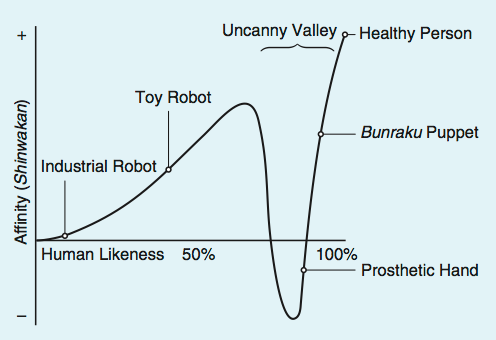Further Thoughts on “The Uncanny”
Grace Lapointe
TW for ableism
I wanted to expand on my recent Book Riot article and subsequent Twitter threads on Freud’s “The Uncanny,” in several different directions. The uncanny, as Freud and others defined and applied it, is an explicitly ableist concept.
FREUD’S ETYMOLOGIES
Knowing that Sigmund Freud first published this essay as “Das Unheimliche” in German in 1919, he is concerned with its etymology in German in a way that is untranslatable.
Freud says, “Thus heimlich is a word the meaning of which develops in the direction of ambivalence, until it finally coincides with its opposite, unheimlich. Unheimlich is in some way or other a sub-species of Heimlich (4).” I wrote on BR: “In other words, it’s not unfamiliarity itself, but the inability to tell whether something is familiar or unfamiliar, which is so unsettling and threatening.” That’s my definition of the uncanny — or more precisely, my interpretation of Freud’s definition.
For Freud, the paradox of the heimlich is the point where these two contradictory meanings blur: “on the one hand, it means that which is familiar and congenial, and on the other, that which is concealed and kept out of sight. Everything is uncanny that ought to have remained hidden and secret, and yet comes to light (Freud 4).” Heimlich, homey, has a secondary meaning close to hidden or clandestine, which is where it becomes the Unheimlich or uncanny.
I find Freud’s idea of something “that ought to have remained hidden and secret, and yet comes to light” chilling as a disabled person. Many family secrets can be described in this way. Indeed, in many cultures and eras, including the society in which Freud was writing, disabled people were often treated as this kind of shameful secret. People born with physical or intellectual disabilities were often institutionalized immediately. Others were institutionalized later, if they acquired or showed symptoms of disability, including mental illness.
Before education and other civil rights for disabled people were protected by law, their families had two main options: to institutionalize them or keep them at home. They were often literally kept at home, barely leaving the house. Some relatives hid, abused, or shipped away disabled people because having genetic disability in the family made neighbors consider the non-disabled family members impossible to marry.
This brings us back to the idea of familiarity vs. unfamiliarity. The more secluded and less integrated disabled people are, the stranger and more uncanny we may seem to abled people. Of course, this is a vicious cycle, meaning that we get even further marginalized and stigmatized.
Freud directly, repeatedly relates the uncanny to disabled people. He cites examples from other scholars: “[E. Jentsch] adds to this class the uncanny effect of epileptic seizures and the manifestations of insanity, because these excite in the spectator the feeling that automatic, mechanical processes are at work, concealed beneath the ordinary appearance of animation” (Freud 5).
As I wrote on Twitter: if you witness an epileptic seizure and are scared not for the person’s safety but because they remind you of a robot or automaton, I don’t know what to tell you! This is blatant dehumanization and objectification.
So, is the Uncanny the abled gaze? Not exactly — I often felt it very strongly, but not with regard to my disability. But does the abled gaze often perceive us as uncanny in contrast to its arbitrary norms? For me, that’s the right question.
Connection to Obsessive Compulsive Disorder
I talk about having cerebral palsy all the time, but I mention less often that I was diagnosed with OCD as an adult. I think OCD, maybe even more than having CP or always being considered gifted/smart, helps explain my childhood reactions. I wanted to understand the world — and I thought I did. Challenging that control and knowledge felt threatening.
Freud mentions a lot of topics that, to me, feel unrelated. For example, he discusses a “neurotic” patient. But in modern terms, this is the magical thinking and desire for order often found in OCD and similar mental illnesses. He says that a patient once wished that another man would drop dead — and then, mysteriously, the second man did!
Like most mentally ill people, I’ve never wished harm on anyone. But whether you’re willing, or praying for, someone’s death or for their safety and health, the mechanism of illogical thinking is the same: overstating your own significance and influence, good or bad.
Freud also mentions obsessions with repeating rituals (common in OCD), including numbers. Freud and his patients see the same number repeated and then become paranoid that this is significant to them, for example, their age or date of death.
I try to think logically and avoid superstitions. I see this phenomenon as an example of confirmation bias. I always seem to be reading a book or watching a movie that mentions the exact date I’m reading or watching. Obviously, this is a fallacy. My brain disregards countless times when this is not true.
Freud also talks about circular thinking in “The Uncanny” — sometimes literally walking in circles! Our professor’s example was The Blair Witch Project. Freud discusses getting lost in the “red light district” and feeling ashamed and trapped because he hadn’t meant to be there.
Ironically, GPS is a perfect, contemporary example of this. We trust this technology to be accurate, but it often isn’t. All it takes is construction, outdated software, or a lost satellite to send us walking or driving in circles. This is a singularly uncanny experience because people like me trust technology more than our own senses of direction in unfamiliar places. And yet, here it goes, telling me left is right or an old house is an Italian restaurant (both have really happened to me!)
Who is a Human?
“That’s what I don’t understand, Mr. Beaver,” said Peter, “I mean isn’t the Witch herself human?”
“She’d like us to believe it,” said Mr. Beaver, “and it’s on that that she bases her claim to be Queen. But she’s no Daughter of Eve… She comes of your father Adam’s … first wife, her they called Lilith…That’s what she comes from on one side. And on the other she comes of the giants. No, no, there isn’t a drop of real Human blood in the Witch (Lewis 147).”
— CS Lewis, The Lion, the Witch, and the Wardrobe
This is a book that I first read around age seven, and much later, I considered this passage an example of the uncanny. Mr. Beaver says that anything that looks or pretends to be human, but isn’t, is evil and deceptive. Note that he’s an anthropomorphic beaver, who talks like a human. But I’d argue that he looks so unlike a human that he’s far from the uncanny valley. Jadis (the Witch), however, is right in the middle of the valley because she appears human.
The idea that there are beings that look or aspire to be human, but really aren’t, is an odd one for an allegorical, children’s fantasy novel. It has some theological precedent in angels and demons, though. It’s especially strange because the book is so moralistic and symbolic and is set against the backdrop of World War II.
I want to interrogate this gut reaction of “Oooh, IT looks ALMOST human but isn’t — scary!”
Humans vary a lot in gender, sexuality, race, disability, etc. So, what exactly makes someone seem human or not? If you define anything that diverges from the norm as deviant, inferior, or evil, you’ll exclude a lot of people for various racist, ableist, sexist, etc. reasons. There’s no reason to think that someone who looks, walks, acts, or thinks differently is necessarily creepy. That’s prejudice and arbitrary. And how might this idea be applied? What would it look like, in our world? The author’s intent or lack thereof isn’t everything.
Here in Narnia, with its blatant religious allegory, humanity is determined by Christian theology! Jadis’ claim to be Queen is her lineage, a concept often used in the Bible. Mr. Beaver uses theology to claim that Jadis is lying about her lineage and therefore her claim is illegitimate. Ironically, the Pevensie children, and we as readers, have no proof of this either way. In Narnia, everyone must pick a side on the basis of faith, though there’s room for Edmund to be forgiven. We see undeniable evidence of Aslan’s omnipotence when he resurrects himself and others in a symbolic Final Judgment. Even little kids can pick up on (or understand if it’s explained to them) that Aslan symbolizes Jesus. There’s sin, crucifixion, and then resurrection.
Narnia is also Christian theology in a slightly subtler way: humans as made in God’s image and therefore heirs of His Kingdom and the stewards of creation. There’s a clear hierarchy. The animals and other creatures, like fauns, are in awe of the four Pevensies when they meet them. They revere but they don’t worship them — a distinction Christianity makes.
But the creatures view the human children as superior to themselves. They’re thrilled to meet humans and always call the children “Sons of Adam and Daughters of Eve.” This is exactly what Jadis claims to be and what they say she isn’t. There are also hierarchies of creation in Aristotle, but it’s hardly universal. Many cultures have traditionally seen humans as an inseparable part of nature, not its stewards.
And of course, we have a gender hierarchy (patriarchy). Jadis calls herself queen, but Aslan is the legitimate king, all-powerful and good, of course.
THE UNCANNY VALLEY GRAPHS
In my essay, I mention that the uncanny valley was plotted on a graph that resembled a bell curve. What else looks like a bell curve? Another incredibly ableist construct: IQ scores! The IQ bell curve is kind of an inversion of the uncanny valley one. With IQ, “normal/average” is in the middle, with “intellectual disability” and “genius” at the extremes.
In the uncanny, “normal” is on the ends, with the uncanny valley in the middle. This just goes to show how arbitrary these concepts, and the attempts to quantify them, are.
Are these graphs real? Yes: real, common, and still in use.

This graph is from Masahiro Mori’s 1970 essay defining the uncanny valley. Notice “healthy person” way at the top of the axis, with a prosthetic hand at the bottom, way in the valley. This graph is the one that I’ve seen in many articles on the uncanny valley, robots, etc. published 2015–19. So, is it still a very ableist concept? I would argue yes. Explicitly yes.
These articles aren’t doing what I’m trying to do, which is point out the ableism. They’re presenting the uncanny valley at face value, sometimes using it in essays on horror movies. These ideas are still interesting and worthwhile to teach if we can critique them from different perspectives.
I’ve said before: much of the Western literary and philosophical canon is inherently ableist. It’s embedded. Critical theory doesn’t judge authors for being products of their times — a common misconception. It shows how these unquestioned biases influenced culture broadly.
